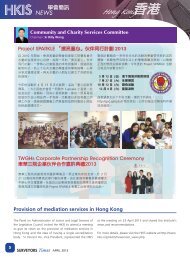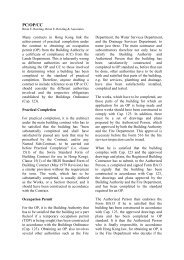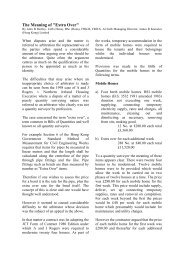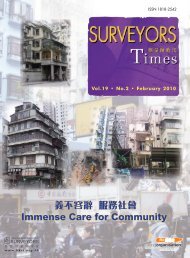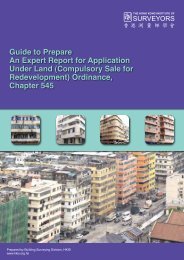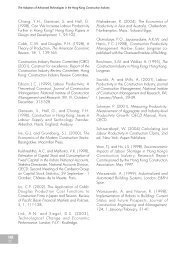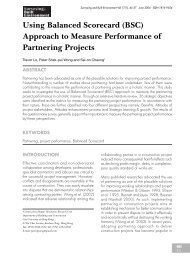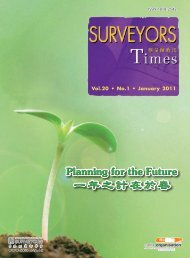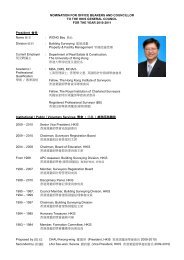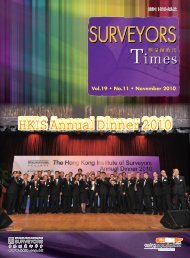Surveying & Built Environment Vol. 22 Issue 1 (December 2012)
Surveying & Built Environment Vol. 22 Issue 1 (December 2012)
Surveying & Built Environment Vol. 22 Issue 1 (December 2012)
Create successful ePaper yourself
Turn your PDF publications into a flip-book with our unique Google optimized e-Paper software.
Editorial<br />
REClAIM AS MuCH AS poSSIBlE ANd No To<br />
uNplANNEd ANd pIECEMEAl REClAMATIoNS<br />
150 persons migrate to Hong Kong from China per day and one can<br />
work out that the Special Administrative Region needs a new town<br />
with a capacity house 0.4 million people per decade. The question is<br />
therefore: where to develop a settlement of this scale on a rolling 10-year<br />
programme (of which nothing of the sort exists in the official territorial<br />
planning statement Hong Kong 2030)?<br />
There is no doubt that reclamation is generally the best strategy to<br />
accommodate a growing population in that it can bypass the complicated<br />
webs of local interests and development controls. The controversies<br />
arising from government determination to develop a small new town in<br />
the Northeastern New Territories testify to this consideration.<br />
If Victoria Harbour and the Country Parks and their fringing Green Belts<br />
are treated as untouchable for urban development, then the government<br />
has the choice of making existing development denser, opening up<br />
agricultural lots in the New Territories and reclamation outside Victoria<br />
Harbour. The last option is not only the easiest but can also be the most<br />
innovative. That is because it can provide opportunities for imaginative<br />
ecological planning efforts for a huge new development area (which<br />
need not be in one piece and can be in the form of a series of man-made<br />
islands) with its own CBD, port, reservoirs and industries that satisfy the<br />
long term economic and recreational needs for the next 50 to 60 years (Lai<br />
2011). The plan horizon must transcend the electoral terms of government<br />
so that the matter ceases to be politicized by short term interests. The scale<br />
must be able to accommodate another 6 to 7 million people to provide<br />
the steady stream of land supply needed. That is the only way to correct<br />
present expectation about property prices. Details are merely engineering.<br />
For instance, there should no lack of fill materials as the government has<br />
been shipping unused fill materials to China, at a cost.<br />
However, scale economies, along with ecological and urban design<br />
concerns, call for a large and comprehensively designed scenario<br />
capable of further growth rather than minuscule, make-shift, piecemeal,<br />
and thoughtless “options” that are on plans manifested by drawing<br />
straight lines across natural coves. Options in government consultative<br />
SBE<br />
5



